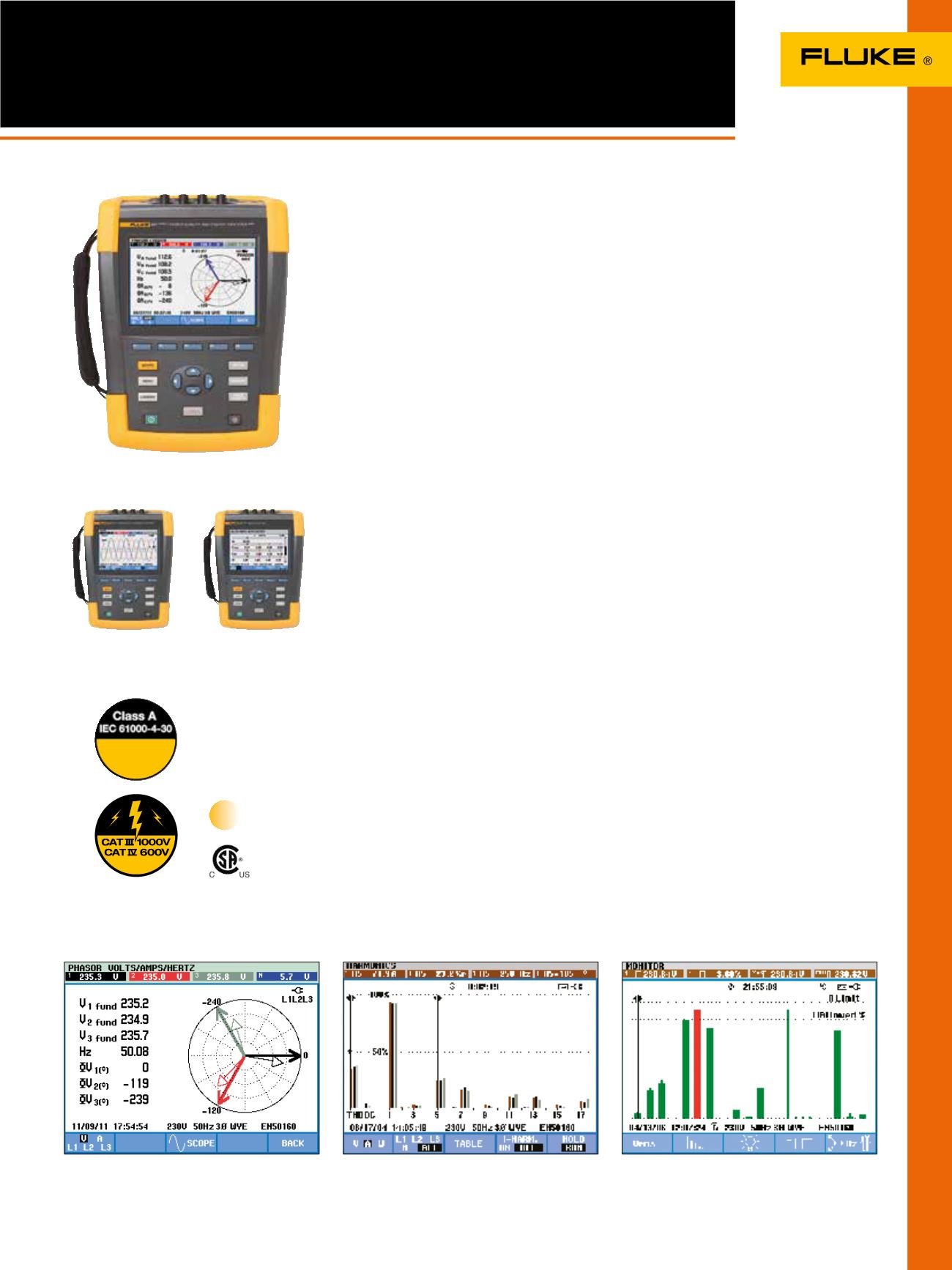

Compliant
Fluke
435 II / 437 II
109
430 Series II Three-Phase Power
Quality and Energy Analyzers
More detailed power quality analysis capability,
and a Fluke-patented energy monetization function
The Fluke 434, 435 and 437 Series II models help
locate, predict, prevent, and troubleshoot power
quality problems in three-phase and single-phase
power distribution systems. Additionally, the
Fluke-patented energy loss algorithm, Unified
Power Measurement, measures and quantifies
energy losses due to harmonics and unbalance
issues, allowing the user to pinpoint the origin of
energy waste within a system.
• Energy loss calculator: Classic active and reactive
power measurements, unbalance and harmonic
power, are quantified to pinpoint true system
energy losses in dollars.
• Power inverter efficiency: Simultaneously
measure AC output power and DC input power
for power electronics systems using optional DC
clamp.
• PowerWave data capture: 435 and 437 Series II
analyzers capture fast RMS data, show half-cycle
and waveforms to characterize electrical system
dynamics (generator start-ups, UPS switching
etc.).
• Waveform capture: 435 and 437 Series II models
capture 100/120 cycles (50/60Hz) of each event
that is detected in all modes, without set-up.
• Automatic Transient Mode: 435 and 437 Series
II analyzers capture 5 μs transient data on all
phases simultaneously up to 6 kV.
• Fully Class-A compliant: 435 and 437 Series II
analyzer conduct tests according to the stringent
international IEC 61000-4-30 Class-A standard
with 435 and 437 Series II analyzers.
• 400 Hz measurement: 437 Series II analyzer
captures power quality measurements for avionic
and military power systems.
• Troubleshoot real-time: Analyze the trends using
the cursors and zoom tools.
• Highest safety rating in the industry: 600 V CAT IV/
1000 V CAT III rated for use at the service
entrance.
• Automatic Trending: Every measurement is
always automatically recorded, without any
set-up.
• System-Monitor: Ten power quality parameters
on one screen according to EN50160 power
quality standard
• Logger function: Configure for any test condition
with memory for up to 150 parameters on each
phase/neutral at user defined intervals.
Unified Power Measurement
Fluke’s patented Unified Power Measurement
system (UPM) provides the most comprehensive
view of power available, measuring:
• Parameters of Classical Power (Steinmetz 1897)
and IEEE 1459-2000 Power
• Detailed Loss Analysis
• Unbalance Analysis
• These UPM calculations are used to quantify in
local currency the cost of energy loss caused by
power quality issues.
Energy savings
The cost of power quality could only be
quantified in terms of downtime caused by lost
production and damage to electrical equipment.
The Unified Power Measurement (UPM) method
now goes beyond this to achieve energy savings
by discovering the energy waste caused by
power quality issues. Using the Unified Power
Measurement, Fluke’s Energy Loss Calculator will
determine how much money as facility is losing
due to waste energy.
Unbalance
UPM gives a more comprehensive breakdown of
the energy consumed in the plant. In addition
to measuring reactive power (caused by poor
power factor), UPM also measures the energy
waste caused by unbalance; the effect of unevenly
loading each phase in three-phase systems.
Harmonics
UPM also provides details of the energy wasted
in your facility due to the presence of harmonics.
The presence of harmonics in your facility can
lead to:
• Overheating transformers and conductors
• Nuisance tripping of circuit breakers
• Early failures of electrical equipment
Fluke 437-II
Fluke 435-II
Fluke 434-II
True RMS
On all inputs
Track harmonics up to the 50th, and measure and record
THD in accordance with IEC61000-4-7 requirements.
The System-Monitor overview gives instant insight into
whether the voltage, harmonics, flicker, frequency and
the number of dips and swells fall outside the set limits.
A detailed list is given of all events falling outside the
set limits.
Phasor diagram.










